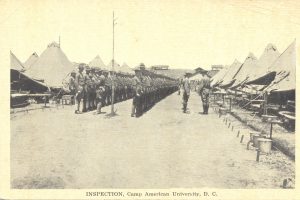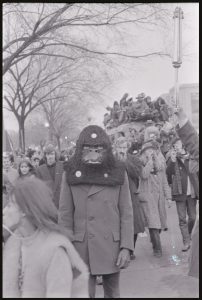AU Archives and Special Collections is pleased to announce its newest exhibit featuring woodblock prints of the Tōkaidō Road from the Charles Nelson Spinks Collection. It will be on display through the end of the summer at AU Archives on the second floor of the Spring Valley building. The images on display will rotate so feel free to drop by more than once.
Author Archives: admin
On Display – World War I Remembered: Camp American University
In 1917, American University (AU) offered the government use of its unfinished campus for army training. At the time, AU only had two buildings Hurst Hall and McKinley. The Army used both buildings during the war years. The government established two separate camps, Camp American University and Camp Leach. The largest operation was the Engineer Officers’ Reserve Corps training camp. Camp Leach also offered training for camouflagers and foresters. Camp American University was the birthplace of American chemical warfare. Scientists working with the army’s Gas and Flame Battalion (the 30th Engineers) developed gases and apparatuses for use at the front.
A new exhibit on the first floor of Bender Library featuring photographs and postcards of Camp American University and Camp Leach will be on display through the end of 2018.
Protest Costumes
In remembrance of last year’s historic women’s march and the pussy hat, we decided to explore protest costumes. Protesters express themselves through the messages on their signs as well as their clothing. In looking through the images taken by Eagle photographers and Patrick Frazier, we discovered one recurring theme – animal costumes and masks. We selected three images that display the creativity of protesters.
The numerous anti-war protests held in Washington, D.C. in the 1960s and 1970s offer a window into protest attire. Though the theme of the protests were similar, the signs and costumes were not. Some costumes were simple a mask while others were more elaborate. In some instances, the sign was an integral part of the costume. It provided the storyline.
The Patrick Frazier Collection includes images from both of the Nixon counter-inaugural protests. The first in 1969 was the largest anti-war protest in United States history. It included a parade with street theater and marching kazoo bands. In this image, the people behind the protester in the guerrilla mask are playing kazoos.
The second in 1973 centered on the capitol grounds. In this image, the costumed protester’s sign underscores the concerns of the marchers.

Participants in the counter-inaugural demonstrations during Nixon’s second inauguration on January 20, 1973
When the AU Chapter of the Young Americans for Freedom invited Secretary of the Interior James Watt to speak at AU on February 10, 1983, 150 protesters from the AU chapter of Americans for Democratic Action and the College Democrats chanted, “Watt must go” and sang, “This Land is My Land” outside the ticketed event. In this image, AU Student Jessica Cohen is wearing a rabbit costume and holding a bunch of carrots. Her sign had a personal message for Secretary Watt.
Staff Favorites in Special Collections
And for the final post celebrating our new home, we are going to talk about the stuff instead. Highlights from our rare book collection include 19th century American mathematics textbooks and Japanese wood block prints. Our manuscript collections document a variety of disciplines such as journalism and public service. Two of our most recent collecting initiatives relate to Peace Corps volunteers and social/political protest.
We polled staff members and asked them for their favorite items. Here are our top five:
Counter-inaugural demonstration image from the Frazier Collection. Leslie appreciated the costume and sign especially where it says “Hi Mom!”

Protester in animal costume holding a protest sign at President Nixon’s second inauguration in 1973.
Arithmetica Boetij.Augsburg, Erhard Ratdolt, 20 May 1488. Susan noted that it is a wonderful resource for showing the components of a book with its leather cover and wooden boards. It includes the first use of a multiplication table.
Reporter Gregg Jones covered the People Power Revolution in the Philippines in 1986. He conducted interviews with members of the New People’s Army, including the founder of the Communist Party of the Philippines, Jose Maria Sison. Katie found intriguing Jones’ descriptions of the process of getting the interviews. Jones befriended NPA members and went for rides with them in rebel territory.
Women Strike for Peace created this coloring book to educate young people about the dangers of nuclear war. Susan found fascinating the concept of a coloring book with such dark images.
Nicaraguan market scene from Gentile Collection. Leslie liked the composition of this image which brings to life the wares and people at this market.
Behind the Scenes at AU Archives in Spring Valley
This is the third post about our new home in AU’s Spring Valley Building.
As we worked with the architects on the design for our new space, we realized we could facilitate our work through adjacencies and review of traffic patterns. Our new work area combines our digitization lab and processing space so staff are co-located and can better work together on projects. As it can be easier to sort collections while standing, our main tables are bar height. Our digitization stations are along the walls to limit disruptions. The new configuration gave us enough additional space to set up an audio-visual digitization station so we can offer a broader array of reformatting services to researchers. We can also use this extra computer for digital collections processing.
We are excited about our new storage area, which features state of the art climate control and mobile shelving. The archives stacks contains two units of mobile shelving with stationary shelves along the perimeter. The new shelving configuration features a variety of sizes of shelves that maximize our storage capacity. AU archives for the first time in many years has growth space on campus. We have many new collections in the pipeline so it will be interesting to see how fast the open space fills up. Our new HVAC system will allow us to better control seasonal fluctuation of temperature and relative humidity to protect our collections for the long haul. One nice bonus is that all of our map cabinets are now with the climate control zone.
Welcome to the new Archives Reading Room
This is the second in a series of posts about our new home in AU’s Spring Valley Building (SVB).
One exciting feature in our new space is a larger reading room that can accommodate more researchers and larger classes. The desks and chairs are all on wheels so we can move them around to allow for varying configurations. With a full AV set up, we can easily host lectures and presentations. We also added a light table for viewing slides and negatives and a public workstation so researchers can search the catalog and/or view our digital collections if they do not bring their own device. As with all campus buildings, SVB offers free wifi for guests. We have a few lockers for secure storage of valuables. To facilitate access to collections from off-site storage, we set aside some space to store materials temporarily while researchers are using them.
Researcher appointments are available between 9am and 5pm Monday through Friday. Faculty members should contact the University Archivist at least two weeks in advance of their proposed class visit.
Welcome to the New AU Archives and Special Collections
This is a first in a series of posts introducing our new space.
Upon entering American University Archives and Special Collections, visitors encounter colorful displays of treasures from Special Collections. Our new entrance features motion activated lighting and temperature and humidity control. This will allow us to display a broader range of materials from our collections. We plan to change our exhibits more frequently to encourage repeat visits.
Our first two displays in this space feature items from the rare book collection. 19th century illustrators and American authors take center stage. The varied styles of the illustrators and the colorful book jackets vie for your attention. These items will remain on display up until winter break.
Visitors are welcome to stop by between 9am-5pm Monday through Friday.
On Display – From Farm to Urban Campus: Campus Design through the Years
Campus planning is both an art and a science. Campus leaders and planners work together to create a vision and plan. They study factors such as enrollment, traffic patterns, open space, and sustainability goals. A new exhibit on the first floor of Bender Library uses maps and photographs to illustrate the development of American University’s campus from its purchase to the present day. The exhibit will be on display through the end of the fall semester.
Unpacking progressing smoothly
AU Archives and Special Collections staff and students have been hard at work the last couple of weeks unpacking the rare book collection. We have made substantial enough progress that the Archives Reading Room will re-open on October 4. We hope to have everything unpacked by October 6. Our final move related task will be to do a shelf read to make sure that everything is where it belongs.
Here are some images of our new shelves loaded with books and boxes:
Visitors are welcome. Give us a call at (202) 885-3256 or email archives@american.edu if you would like a tour or need to consult a collection.
AU Archives is Moving
AU Archives and Special Collections will be moving to our new home on the second floor of the Spring Valley Building (4801 Massachusetts Avenue NW) the last two weeks of August. We will be monitoring email sporadically during the move so our response time will be slower than usual. Starting September 5, we will provide limited reference service until the rare book collection has been unpacked and shelved. We hope to establish full operations in early October if not sooner.
We will begin accepting donations again starting the week of Labor Day.
Our new mailing address is as follows:
American University
4400 Massachusetts Ave NW
Archives & Special Collections – Suite 207
Washington DC 20016-8042
For FedEX and UPS shipments please use the following address:
American University
4801 Massachusetts Ave NW
Archives & Special Collections – Suite 207
Washington DC 20016-8042
Researchers are welcome to contact us starting the week of September 14 to schedule appointments for late September and early October.
This is a preliminary schedule so please call or email to confirm.




















